Determining the Effect of Different Concentrations of Spent Coffee Grounds on the Metabolomic Profile of Swiss Chard
Abstract
1. Introduction
2. Materials and Methods
2.1. Leaf Collection and Preparation
2.2. NMR Metabolomics Analysis
3. Results
The Impact of Varying Levels of SCGs on the Metabolomic Profile of Swiss Chard at Initial and Second Harvest
4. Discussion
5. Conclusions
Author Contributions
Funding
Institutional Review Board Statement
Data Availability Statement
Acknowledgments
Conflicts of Interest
References
- Falcon, W.P.; Naylor, R.L.; Shankar, N.D. Rethinking global food demand for 2050. Popul. Dev. Rev. 2022, 48, 921–957. [Google Scholar] [CrossRef]
- Rivelli, A.R.; Libutti, A. Effect of biochar and inorganic or organic fertilizer co-application on soil properties, plant growth and nutrient content in Swiss chard. Agronomy 2022, 12, 2089. [Google Scholar] [CrossRef]
- Franca, A.S.; Oliveira, L.S. Potential uses of spent coffee grounds in the food industry. Foods 2022, 11, 2064. [Google Scholar] [CrossRef]
- Cervera-Mata, A.; Delgado, G.; Fernández-Arteaga, A.; Fornasier, F.; Mondini, C. Spent coffee grounds by-products and their influence on soil C–N dynamics. J. Environ. Manag. 2022, 302, 114075. [Google Scholar] [CrossRef]
- Vu, D.C.; Vu, Q.T.; Huynh, L.; Lin, C.H.; Alvarez, S.; Vo, X.T.; Nguyen, T.H. Evaluation of fatty acids, phenolics and bioactivities of spent coffee grounds prepared from Vietnamese coffee. Int. J. Food Prop. 2021, 24, 1548–1558. [Google Scholar] [CrossRef]
- Campos-Vega, R.; Loarca-Pina, G.; Vergara-Castaneda, H.A.; Oomah, B.D. Spent coffee grounds: A review on current research and future prospects. Trends Food Sci. Tech. 2015, 45, 24–36. [Google Scholar] [CrossRef]
- Hardgrove, S.J.; Livesley, S.J. Applying spent coffee grounds directly to urban agriculture soils greatly reduces plant growth. Urban For. Urban Green. 2016, 18, 1–8. [Google Scholar] [CrossRef]
- Comino, F.; Cervera-Mata, A.; Aranda, V.; Martín-García, J.M.; Delgado, G. Short-term impact of spent coffee grounds over soil organic matter composition and stability in two contrasted Mediterranean agricultural soils. J. Soils Sediments 2020, 20, 1182–1198. [Google Scholar] [CrossRef]
- Yamane, K.; Kono, M.; Fukunaga, T.; Iwai, K.; Sekine, R.; Watanabe, Y.; Iijima, M. Field evaluation of coffee grounds application for crop growth enhancement, weed control, and soil improvement. Plant Prod. Sci. 2014, 17, 93–102. [Google Scholar] [CrossRef]
- Cervera-Mata, A.; Pastoriza, S.; Rufán-Henares, J.Á.; Párraga, J.; Martín-García, J.M.; Delgado, G. Impact of Spent Coffee Grounds as organic amendment on soil fertility and lettuce growth in two Mediterranean agricultural soils. Arch. Agron. Soil Sci. 2018, 64, 790–804. [Google Scholar] [CrossRef]
- Ustundag, U.V.; Tunali, S.; Alev, B.; Ipekci, H.; Emekli-Alturfan, E.; Akbay, T.T.; Yanardag, R.; Yarat, A. Effects of Chard (Beta vulgaris L. var. Cicla) on Cardiac Damage in Valproic Acid–Induced Toxicity. J. Food Biochem. 2016, 40, 132–139. [Google Scholar] [CrossRef]
- Abu-Ellail, F.F.; Salem, K.F.; Saleh, M.M.; Alnaddaf, L.M.; Al-Khayri, J.M. Molecular Breeding Strategies of Beetroot (Beta vulgaris ssp. vulgaris var. conditiva Alefeld). In Advances in Plant Breeding Strategies, Vegetable Crops, Bulbs, Roots, and Tubers; Springer: Berlin/Heidelberg, Germany, 2021; pp. 157–212. [Google Scholar]
- Libutti, A.; Rivelli, A.R. Quanti-qualitative response of Swiss chard (Beta vulgaris L. var. cycla) to soil amendment with biochar-compost mixtures. Agronomy 2021, 11, 307. [Google Scholar] [CrossRef]
- Simko, I.; Hayes, R.J.; Mou, B.; McCreight, J.D. Lettuce and spinach. Yield Gains Major US Field Crops 2014, 33, 53–85. [Google Scholar]
- Sindesi, O.A. Water and Nutrient Retention Under Swiss Chard (Beta vulgaris var. cicla) and Cabbage (Brassica oleracea var. capitata L.) Cultivated in Soil Amended with Zeolite. Master’s Thesis, Cape Peninsula University of Technology, Cape Town, South Africa, 2020. [Google Scholar]
- Ninfali, P.; Angelino, D. Nutritional and functional potential of Beta vulgaris cicla and rubra. Fitoterapia 2013, 89, 188–199. [Google Scholar] [CrossRef] [PubMed]
- Ivanović, L.; Milašević, I.; Topalović, A.; Ðurović, D.; Mugoša, B.; Knežević, M.; Vrvić, M. Nutritional and phytochemical content of Swiss chard from Montenegro, under different fertilization and irrigation treatments. Br. Food J. 2019, 121, 411–425. [Google Scholar] [CrossRef]
- Maboko, M.M.; Du Plooy, C.P.; Sithole, M.A.; Mbave, A. Swiss chard (Beta vulgaris L.) water use efficiency and yield under organic and inorganic mulch application. J. Agric. Sci. Technol. 2017, 19, 1345–1354. [Google Scholar]
- Nair, L.P.S. Consumption of Fruits and Vegetable Among Adolescent Girls. Bachelor’s Thesis, St Teresa’s College (Autonomous), Ernakulam, India, 2023. [Google Scholar]
- Mzoughi, Z.; Chahdoura, H.; Chakroun, Y.; Cámara, M.; Fernández-Ruiz, V.; Morales, P.; Mosbah, H.; Flamini, G.; Snoussi, M.; Majdoub, H. Wild edible Swiss chard leaves (Beta vulgaris L. var. cicla): Nutritional, phytochemical composition and biological activities. Food Res Int. 2019, 119, 612–621. [Google Scholar]
- Ndololwana, N.G. The Use of Winery Waste Compost to Establish Cabbage (Brassica oleracea var. capitata L.) and Swiss Chard (Beta vulgaris subsp. cycla) on Sandy Soil at Bien Donné Experimental Farm Near Paarl in the Western Cape Region. Master’s Thesis, Cape Peninsula University of Technology, Cape Town, South Africa, 2015. [Google Scholar]
- Matlala, M.N. Estimating the Volumetric Water Footprint of SWISS Chard (Beta vulgaris) and Carrot (Daucus carota) Grown in the Highveld Region, South Africa. Master’s Thesis, University of Pretoria, Pretoria, South Africa, 2017. [Google Scholar]
- Oelofse, A.; Van Averbeke, W.; Van Jaarsveld, P. The Nutritional Value, Water Use and Nutrient Contribution of Traditional African Leafy Vegetables. Ann. Nutr. Metab. 2013, 63, 495. [Google Scholar]
- Johnson, R.K.; Appel, L.J.; Brands, M.; Howard, B.V.; Lefevre, M.; Lustig, R.H. American Heart Association Nutrition Committee of the Council on Nutrition, Physical Activity, and Metabolism and the Council on Epidemiology and Prevention. Dietary sugars intake and cardiovascular health: A scientific statement from the American Heart Association. Circulation 2009, 120, 1011–1020. [Google Scholar]
- Nemadodzi, L.E.; Vervoort, J.; Prinsloo, G. NMR-Based Metabolomic Analysis and Microbial Composition of Soil Supporting Burkea africana Growth. Metabolites 2020, 10, 402. [Google Scholar] [CrossRef]
- Nakabayashi, R.; Saito, K. Higher dimensional metabolomics using stable isotope labeling for identifying the missing specialized metabolism in plants. Curr. Opin. Plant Biol. 2020, 55, 84–92. [Google Scholar] [CrossRef] [PubMed]
- Griffiths, W.J.; Koal, T.; Wang, Y.; Kohl, M.; Enot, D.P.; Deigner, H.P. Targeted metabolomics for biomarker discovery. Angew. Chem. Int. Ed. Engl. 2010, 49, 5426–5445. [Google Scholar] [CrossRef] [PubMed]
- Bujak, R.; Struck-Lewicka, W.; Markuszewski, M.J.; Kaliszan, R. Metabolomics for laboratory diagnostics. J. Pharm. Biomed. Anal. 2015, 113, 108–120. [Google Scholar] [CrossRef] [PubMed]
- Gupta, S.; Schillaci, M.; Roessner, U. Metabolomics as an emerging tool to study plant–microbe interactions. Emerg. Top. Life Sci. 2022, 6, 175–183. [Google Scholar] [CrossRef]
- Thovhogi, F.; Ntushelo, N.; Gwata, E.T. A Comparative Study of the Presence of Minerals, Flavonoids and Total Phenolic Compounds in the Leaves of Common Traditional Vegetables. Appl. Sci. 2023, 13, 8503. [Google Scholar] [CrossRef]
- Liu, L.; Ueda, A.; Saneoka, H. Physiological responses of white Swiss chard (Beta vulgaris L. subsp. cicla) to saline and alkaline stresses. Aust. J. Crop Sci. 2013, 7, 1046. [Google Scholar]
- Mthimunye, L.M.; Managa, G.M.; Nemadodzi, L.E. The influence of Lablab Purpureus growth on nitrogen availability and mineral composition concentration in nutrient-poor savanna soils. Agronomy 2023, 13, 622. [Google Scholar] [CrossRef]
- Abubbaker, H.M.; Alshareef, I.M.; Binyahmed, F. The Effect of Spent Coffee Residues on the Growth and Productivity of Watercress and Swiss Chard Plants. Sebha Univ. J. Pure Appl. Sci. 2022, 21, 42022. [Google Scholar]
- Nemadodzi, L.E. Growth and Development of Baby Spinach (Spinacia oleracea L.) with Reference to Mineral Nutrition. Master’s Thesis, University of South Africa, Pretoria, South Africa, 2015. [Google Scholar]
- Seidel, S.J.; Werisch, S.; Schütze, N.; Laber, H. Impact of irrigation on plant growth and development of white cabbage. Agric. Water Manag. 2017, 187, 99–111. [Google Scholar] [CrossRef]
- Nemadodzi, L.E.; Managa, G.M. 1H NMR-Based Metabolomics Profile of Green and Red Amaranthus Grown in Open Field versus Greenhouse Cultivation System. Metabolites 2023, 14, 21. [Google Scholar] [CrossRef]
- Kim, H.K.; Choi, Y.H.; Verpoorte, R. NMR-based metabolomic analysis of plants. Nature Protoc. 2010, 5, 536–549. [Google Scholar] [CrossRef] [PubMed]
- Maree, J.; Viljoen, A. Phytochemical distinction between Pelargonium sidoides and Pelargonium reniforme—A quality control perspective. S. Afr. J. Bot. 2012, 82, 83–91. [Google Scholar] [CrossRef]
- Mungofa, N.; Sibanyoni, J.J.; Mashau, M.E.; Beswa, D. Prospective role of indigenous leafy vegetables as functional food ingredients. Molecules 2022, 27, 7995. [Google Scholar] [CrossRef]
- Wishart, D.S.; Oler, E.; Peters, H.; Guo, A.; Girod, S.; Han, S.; Saha, S.; Lui, V.W.; LeVatte, M.; Gautam, V.; et al. MiMeDB: The human microbial metabolome database. Nucleic Acids Res. 2023, 51, 611–620. [Google Scholar] [CrossRef]
- Zhao, L.; Huang, Y.; Hu, J.; Zhou, H.; Adeleye, A.S.; Keller, A.A. 1H NMR and GC-MS based metabolomics reveal defense and detoxification mechanism of cucumber plant under nano-Cu stress. Environ. Sci. Technol. 2016, 50, 2000–2010. [Google Scholar] [CrossRef]
- Valverde, A.; Velazquez, E.; Gutierrez, C.; Cervantes, E.; Ventosa, A.; Igual, J.M. Herbaspirillum lusitanum sp. nov., a novel nitrogen-fixing bacterium associated with root nodules of Phaseolus vulgaris. Int. J. Syst. Evol. Microbiol. 2003, 53, 1979–1983. [Google Scholar] [CrossRef]
- Fan, L.; Zhu, X.; Sun, S.; Yu, C.; Huang, X.; Ness, R.; Dugan, L.L.; Shu, L.; Seidner, D.L.; Murff, H.J.; et al. Ca: Mg ratio, medium-chain fatty acids, and the gut microbiome. Clin. Nutr. 2022, 41, 2490–2499. [Google Scholar] [CrossRef]
- Narayana, A.; Baskaran, S.A.; Amalaradjou, M.A.; Venkitanarayanan, K. Anticarcinogenic properties of medium chain fatty acids on human colorectal, skin and breast cancer cells in vitro. Int. J. Mol. Sci. 2015, 16, 5014–5027. [Google Scholar] [CrossRef]
- Nagao, K.; Yanagita, T. Medium-chain fatty acids: Functional lipids for the prevention and treatment of the metabolic syndrome. Pharmacol. Res. 2010, 61, 208–212. [Google Scholar] [CrossRef]
- Niehaus, M.; Straube, H.; Specht, A.; Baccolini, C.; Witte, C.P.; Herde, M. The nucleotide metabolome of germinating Arabidopsis thaliana seeds reveals a central role for thymidine phosphorylation in chloroplast development. Plant Cell 2022, 34, 3790–3813. [Google Scholar] [CrossRef]
- Witte, C.P.; Herde, M. Nucleotide metabolism in plants. Plant Physiol. 2020, 182, 63–78. [Google Scholar] [CrossRef] [PubMed]
- Sun, M.; Yang, Z.; Liu, L.; Duan, L. DNA Methylation in Plant Responses and Adaption to Abiotic Stresses. Int. J. Mol. Sci. 2022, 23, 6910. [Google Scholar] [CrossRef] [PubMed]
- Siddiqui, A.; Ceppi, P. A non-proliferative role of pyrimidine metabolism in cancer. Mol. Metab. 2020, 35, 100962. [Google Scholar] [CrossRef]
- Santoso, D.; Thornburg, R. Uridine 5′-monophosphate synthase is transcriptionally regulated by pyrimidine levels in Nicotiana plumbaginifolia. Plant Physiol. 1998, 116, 815–821. [Google Scholar] [CrossRef] [PubMed]
- Cansev, A.; Gülen, H.; Zengin, M.K.; Ergin, S.; Cansev, M. Use of Pyrimidines in Stimulation of Plant Growth and Development and Enhancement of Stress Tolerance; Uludağ Ünïversïtesï Teknolojï Transfer Ofïsï Tïcaret Ve Sanayï Anonïm Şïrketï: Nïlüfer/Bursa, Türkiye, 2014. [Google Scholar]
- De Sousa, C.A.F.; Sodek, L. Alanine metabolism and alanine aminotransferase activity in soybean (Glycine max) during hypoxia of the root system and subsequent return to normoxia. Environ. Exp. Bot. 2003, 50, 1–8. [Google Scholar] [CrossRef]
- Guo, S.H.; Hu, N.; Li, Q.S.; Yang, P.; Wang, L.L.; Xu, Z.M.; Chen, H.J.; He, B.Y.; Zeng, E.Y. Response of edible amaranth cultivar to salt stress led to Cd mobilization in rhizosphere soil: A metabolomic analysis. Environ. Pollut. 2018, 241, 422–431. [Google Scholar] [CrossRef]
- Khan, N.; Bano, A.; Rahman, M.A.; Rathinasabapathi, B.; Babar, M.A. UPLC-HRMS-based untargeted metabolic profiling reveals changes in chickpea (Cicer arietinum) metabolome following long-term drought stress. Plant Cell Environ. 2019, 42, 115–132. [Google Scholar] [CrossRef]
- Holeček, M. Origin and roles of Alanine and glutamine in Gluconeogenesis in the liver, kidneys, and small intestine under physiological and pathological conditions. Int. J. Mol. Sci. 2024, 25, 7037. [Google Scholar] [CrossRef]
- Wang, L.; Mao, Y.; Wang, Z.; Ma, H.; Chen, T. Advances in biotechnological production of β-alanine. World J. Microbiol. Biotechnol. 2021, 37, 79. [Google Scholar] [CrossRef]
- Smolen, A. Vitamin B-6 metabolism and the maternal-fetal relationship. In Vitamin B-6 Metabolism in Pregnancy, Lactation, and Infancy; CRC Press: Boca Raton, FL, USA, 2021; pp. 93–108. [Google Scholar]
- Dos Santos, S.K.; de Azevedo Soares, V.; Dantas, E.F.O.; Dos Santos, L.W.O.; da Silva Gomes, D.; Henschel, J.M.; Batista, D.S. Exogenous carnitine application enhances the growth of culantro (Eryngium foetidum) plants. Vegetables 2023, 36, 393–399. [Google Scholar] [CrossRef]
- Wang, K.; Li, F.; Gao, M.; Huang, Y.; Song, Z. Mechanisms of trehalose-mediated mitigation of Cd toxicity in rice seedlings. J. Clean. Prod. 2020, 267, 121982. [Google Scholar] [CrossRef]
- Turk, H.; Erdal, S.; Dumlupinar, R. Carnitine-induced physio-biochemical and molecular alterations in maize seedlings in response to cold stress. Arch. Agron. Soil Sci. 2020, 66, 925–941. [Google Scholar] [CrossRef]
- Latham, L.E.; Wang, C.; Patterson, T.A.; Slikker, W., Jr.; Liu, F. Neuroprotective effects of carnitine and its potential application to ameliorate neurotoxicity. Chem. Res. Toxicol. 2021, 34, 1208–1222. [Google Scholar] [CrossRef] [PubMed]
- Alhasaniah, A.H. L-carnitine: Nutrition, pathology, and health benefits. Saudi J. Biol. Sci. 2023, 30, 103555. [Google Scholar] [CrossRef] [PubMed]
- Chiang, J.C.B.; Arnold, R.; Dhanapalaratnam, R.; Markoulli, M.; Krishnan, A.V. Current and emerging pharmacotherapeutic interventions for the treatment of peripheral nerve disorders. Pharmaceuticals 2022, 15, 607. [Google Scholar] [CrossRef]
- Foster, D.W. The role of the carnitine system in human metabolism. Ann. N. Y. Acad. Sci. 2004, 1033, 1–16. [Google Scholar] [CrossRef]
- Petric, D. Potential clinical relevance of L-Carnitine supplementation in oncology. Food Ther. Health Care 2022, 4, 7. [Google Scholar] [CrossRef]
- Wang, W.; Pan, D.; Liu, Q.; Chen, X.; Wang, S. L-Carnitine in the Treatment of Psychiatric and Neurological Manifestations: A Systematic Review. Nutrients 2024, 16, 1232. [Google Scholar] [CrossRef]
- Flanagan, J.L.; Simmons, P.A.; Vehige, J.; Willcox, M.D.; Garret, Q. Role of carnitine in disease. Nutr. Metab. 2010, 7, 30. [Google Scholar] [CrossRef]
- McCann, M.R.; George De la Rosa, M.V.; Rosania, G.R.; Stringer, K.A. L-carnitine and acylcarnitines: Mitochondrial biomarkers for precision medicine. Metabolites 2021, 11, 51. [Google Scholar] [CrossRef]
- Wagh, M.S.; Osborne, W.J.; Sivarajan, S. Volatile organic compounds for enhancement of plant growth through plant growth promoting rhizobacteria. In Volatiles and Metabolites of Microbes; Academic Press: Cambridge, MA, USA, 2021; pp. 325–347. [Google Scholar]
- Hughes, M.D., Jr. Investigating the Influence of Fresh and Aged Garlic Extracts on the Biosynthesis of Trimethylamine N-Oxide. Ph.D. Thesis, Virgina Tech, Blacksburg, VA, USA, 2021. [Google Scholar]
- Seth, M.; Mondal, P.; Ghosh, D.; Mukhopadhyay, S.K. The foul play of two dietary metabolites trimethylamine (TMA) and trimethylamine N-oxide (TMAO) on human health and the role of microbes in mitigating their effects. Nutrire 2023, 48, 52. [Google Scholar] [CrossRef]
- Yu, Y.; Gui, Y.; Li, Z.; Jiang, C.; Guo, J.; Niu, D. Induced systemic resistance for improving plant immunity by beneficial microbes. Plants 2022, 11, 386. [Google Scholar] [CrossRef]
- Jorge, N.C.; Souza-Silva, É.A.; Alvarenga, D.R.; Saboia, G.; Soares, G.L.G.; Zini, C.A.; Cavalleri, A.; Isaias, R.M.S. Structural and chemical profiles of Myrcia splendens (Myrtaceae) leaves under the influence of the galling Nexothrips sp. (Thysanoptera). Front. Plant Sci. 2018, 9, 1521. [Google Scholar] [CrossRef]
- Fraser-Andrews, E.A.; Manning, N.J.; Ashton, G.H.; Eldridge, P.; McGrath, J.; Menage Hdu, P. Fish odour syndrome with features of both primary and secondary trimethylaminuria. Clin. Exp. Dermatol. 2003, 28, 203–205. [Google Scholar] [CrossRef] [PubMed]
- Thomas, M.S.; Fernandez, M.L. Trimethylamine N-oxide (TMAO), diet and cardiovascular disease. Curr. Atheroscler. Rep. 2021, 23, 12. [Google Scholar] [CrossRef] [PubMed]
- Janeiro, M.H.; Ramírez, M.J.; Milagro, F.I.; Martínez, J.A.; Solas, M. Implication of trimethylamine N-oxide (TMAO) in disease: Potential biomarker or new therapeutic target. Nutrients 2018, 10, 398. [Google Scholar] [CrossRef]
- Chhibber-Goel, J.; Singhal, V.; Parakh, N.; Bhargava, B.; Sharma, A. The metabolite trimethylamine-N-oxide is an emergent biomarker of human health. Curr. Med. Chem. 2017, 24, 3942–3953. [Google Scholar] [CrossRef]
- Caradonna, E.; Nemni, R.; Bifone, A.; Gandolfo, P.; Costantino, L.; Giordano, L.; Mormone, E.; Macula, A.; Cuomo, M.; Difruscolo, R.; et al. The brain–gut axis, an important player in alzheimer and parkinson disease: A narrative review. J. Clin. Med. 2024, 13, 4130. [Google Scholar] [CrossRef]
- Ghosh, D.; Bernstein, J.A. Health effects of trimellitic anhydride occupational exposure: Insights from animal models and immunosurveillance programs. Clin Rev Allergy Immunol. 2020, 59, 61–77. [Google Scholar] [CrossRef]
- Wang, G.P.; Li, F.; Zhang, J.; Zhao, M.R.; Hui, Z.; Wang, W. Overaccumulation of glycine betaine enhances tolerance of the photosynthetic apparatus to drought and heat stress in wheat. Photosynthetica 2010, 48, 30–41. [Google Scholar] [CrossRef]
- Jain, P.; Pandey, B.; Singh, P.; Singh, R.; Singh, S.P.; Sonkar, S.; Gupta, R.; Rathore, S.S.; Singh, A.K. Plant performance and defensive role of glycine betaine under environmental stress. In Plant Performance Under Environmental Stress: Hormones, Biostimulants and Sustainable Plant Growth Management; Springer: Berlin/Heidelberg, Germany, 2021; pp. 225–248. [Google Scholar]
- Fedotova, M.V.; Kruchinin, S.E. Hydration and ion-binding of glycine betaine: How they may be involved in protection of proteins under abiotic stresses. J. Mol. Liq. 2017, 244, 489–498. [Google Scholar] [CrossRef]
- Alvarenga, L.; Ferreira, M.S.; Kemp, J.A.; Mafra, D. The role of betaine in patients with chronic kidney disease: A narrative review. Curr. Nutr. Rep. 2022, 11, 395–406. [Google Scholar] [CrossRef]
- Apicella, J.M. The Effect of Betaine Supplementation on Performance and Muscle Mechanisms. Master’s Thesis, University of Connecticut, Storrs, CT, USA, 2011. [Google Scholar]
- Volpe, S.L. Choline, Betaine, and Exercise Performance. ACSM’s Health Fit J. 2024, 28, 44–46. [Google Scholar] [CrossRef]
- Bhatt, M.; Di Iacovo, A.; Romanazzi, T.; Roseti, C.; Bossi, E. Betaine—The dark knight of the brain. Bas. Clin. Pharmacol. Toxicol. 2023, 133, 485–495. [Google Scholar] [CrossRef] [PubMed]
- Arumugam, M.K.; Paal, M.C.; Donohue, T.M.; Ganesan, M.; Osna, N.A.; Kharbanda, K.K. Beneficial effects of betaine: A comprehensive review. Biology 2021, 10, 456. [Google Scholar] [CrossRef] [PubMed]
- Tian, L.; Xie, Z.; Lu, C.; Hao, X.; Wu, S.; Huang, Y.; Li, D.; Chen, L. The trehalose-6-phosphate synthase TPS5 negatively regulates ABA signalling in Arabidopsis thaliana. Plant Cell Rep. 2019, 38, 869–882. [Google Scholar] [CrossRef]
- Kosar, F.; Alshallash, K.S.; Akram, N.A.; Sadiq, M.; Ashraf, M.; Alkhalifah, D.H.M.; Abdel Latef, A.A.H.; Elkelish, A. Trehalose-Induced Regulations in Nutrient Status and Secondary Metabolites of Drought-Stressed Sunflower (Helianthus annuus L.) Plants. Plants 2022, 11, 2780. [Google Scholar] [CrossRef]
- Xu, Y.; McRae, D.M.; Leonenko, Z. Quantitative Analysis of the Influence of Trehalose on Amyloid-β Binding to Membranes by Localized Surface Plasmon Resonance Spectroscopy. ACS Omega 2025, 10, 12872–12879. [Google Scholar] [CrossRef]
- Yu, S.; Park, H.; Kim, W. Trehalose inhibits inflammatory responses through mitochondrial reprogramming in raw 264.7 macrophages. Antioxidants 2023, 12, 1166. [Google Scholar] [CrossRef]
- Echigo, R.; Shimohata, N.; Karatsu, K.; Yano, F.; Kayasuga-Kariya, Y.; Fujisawa, A.; Ohto, T.; Kita, Y.; Nakamura, M.; Suzuki, S.; et al. Trehalose treatment suppresses inflammation, oxidative stress, and vasospasm induced by experimental subarachnoid hemorrhage. J. Transl. Med. 2022, 10, 80. [Google Scholar] [CrossRef]
- Mohanan, A.; Kodigudla, A.; Raman, D.R.; Bakka, K.; Challabathula, D. Trehalose accumulation enhances drought tolerance by modulating photosynthesis and ROS-antioxidant balance in drought sensitive and tolerant rice cultivars. Physiol. Mol. Biol. Plants 2023, 29, 2035–2049. [Google Scholar] [CrossRef]
- Nery, D.D.C.M.; da Silva, C.G.; Mariani, D.; Fernandes, P.N.; Pereira, M.D.; Panek, A.D.; Eleutherio, E.C.A. The role of trehalose and its transporter in protection against reactive oxygen species. Biochim. Biophys. Acta (BBA)-Gen. Subj. 2008, 1780, 1408–1411. [Google Scholar] [CrossRef] [PubMed]
- Becerra, J.; Carmona, M.C. Inhibition of plant cytokinesis by deoxyguanosine and caffeine. Plant Cell Rep. 1983, 2, 113–116. [Google Scholar] [CrossRef] [PubMed]
- Garcia-Gil, M.; Tozzi, M.G.; Varani, S.; Della Verde, L.; Petrotto, E.; Balestri, F.; Colombaioni, L.; Camici, M. The combination of adenosine deaminase inhibition and deoxyadenosine induces apoptosis in a human astrocytoma cell line. Neurochem Int. 2015, 80, 14–22. [Google Scholar] [CrossRef] [PubMed]
- Wang, D.; Shi, Q.; Wang, X.; Wei, M.; Hu, J.; Liu, J.; Yang, F. Influence of cow manure vermicompost on the growth, metabolite contents, and antioxidant activities of Chinese cabbage (Brassica campestris ssp. chinensis). Biol. Fertil. Soils 2010, 46, 689–696. [Google Scholar] [CrossRef]
- Steindal, A.L.H.; Rødven, R.; Hansen, E.; Mølmann, J. Effects of photoperiod, growth temperature and cold acclimatisation on glucosinolates, sugars and fatty acids in kale. Food Chem. 2015, 174, 44–51. [Google Scholar] [CrossRef]
- Slavin, J.L. Carbohydrates, Dietary Fiber, and Resistant Starch in White Vegetables: Links to Health Outcomes. Adv. Nutr. 2013, 4, 351–355. [Google Scholar] [CrossRef]
- Stanhope, K.L. Sugar consumption, metabolic disease and obesity: The state of the controversy. Crit. Rev. Clin. Lab. Sci. 2016, 53, 52–67. [Google Scholar] [CrossRef]
- Zhang, Y.; Fu, L.; Jeon, S.J.; Yan, J.; Giraldo, J.P.; Matyjaszewski, K.; Tilton, R.D.; Lowry, G.V. Star polymers with designed reactive oxygen species scavenging and agent delivery functionality promote plant stress tolerance. ACS Nano 2022, 16, 4467–4478. [Google Scholar] [CrossRef]
- Playdon, M.; Sampson, J.N.; Cross, A.J.; Sinha, R.; Guertin, K.A.; Moy, K.A.; Rothman, N.; Irwin, M.L.; Mayne, S.T.; Stolzenberg-Solomon, R. Comparing metabolite profiles of habitual diet in serum and urine. Am. J. Clin. Nutr. 2016, 104, 776–789. [Google Scholar] [CrossRef]
- Guertin, K.A.; Loftfield, E.; Boca, S.M.; Sampson, J.N.; Moore, S.C.; Xiao, Q.; Huang, W.Y.; Xiong, X.; Freedman, N.D.; Cross, A.J.; et al. Serum biomarkers of habitual coffee consumption may provide insight into the mechanism underlying the association between coffee consumption and colorectal cancer. Am. J. Clin. Nutr. 2015, 101, 1000–1011. [Google Scholar] [CrossRef]
- Gamba, M.; Raguindin, P.F.; Asllanaj, E.; Merlo, F.; Glisic, M.; Minder, B.; Bussler, W.; Metzger, B.; Kern, H.; Muka, T. Bioactive compounds and nutritional composition of Swiss chard (Beta vulgaris L. var. cicla and flavescens): A systematic review. Crit. Rev. Food Sci. Nutr. 2021, 61, 3465–3480. [Google Scholar] [CrossRef]
- Gawlik-Dziki, U.; Dziki, L.; Anisiewicz, J.; Habza-Kowalska, E.; Sikora, M.; Dziki, D. Leaves of White Beetroot As a New Source of Antioxidant and Anti-Inflammatory Compounds. Plants 2020, 9, 944. [Google Scholar] [CrossRef]
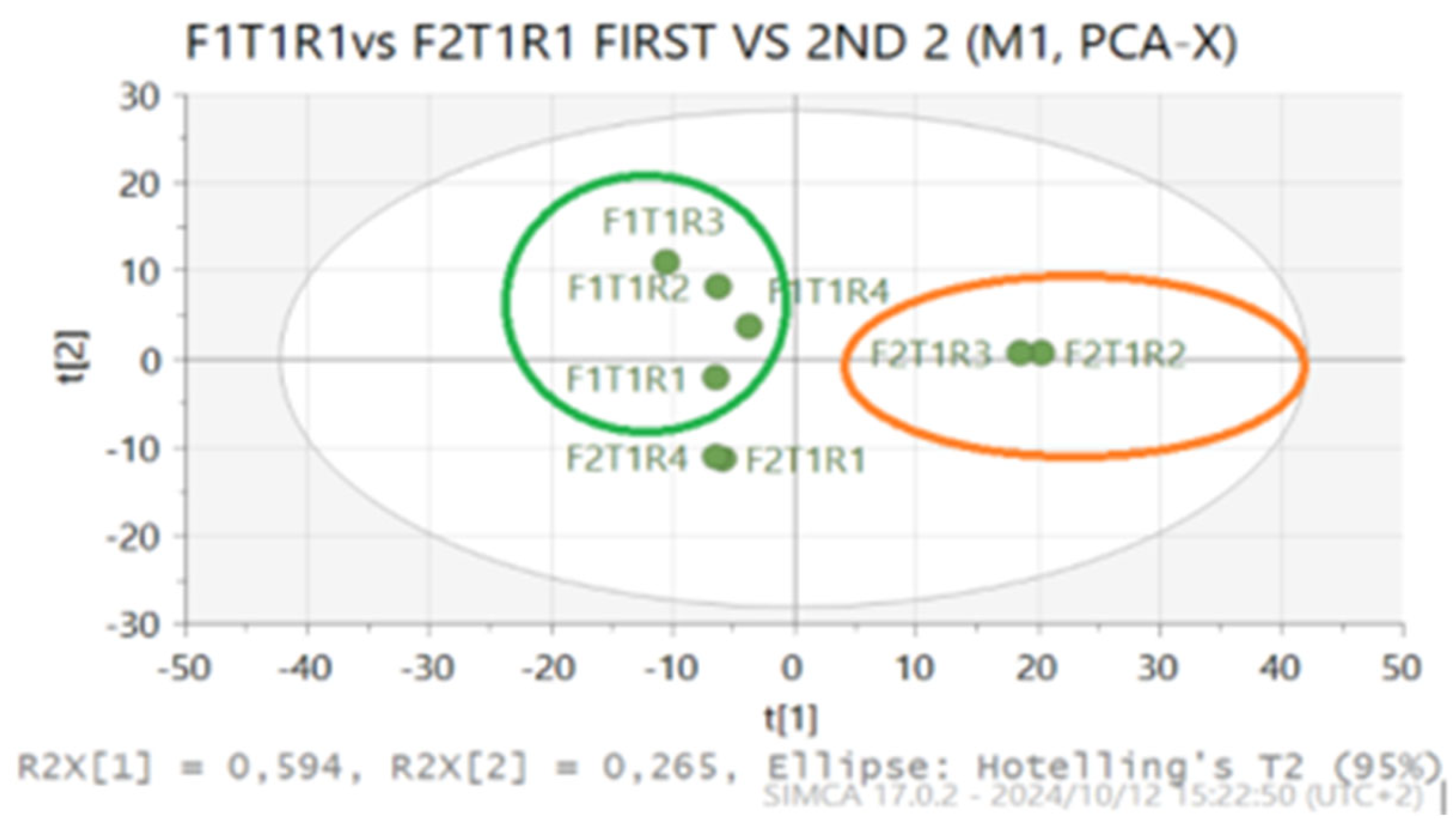
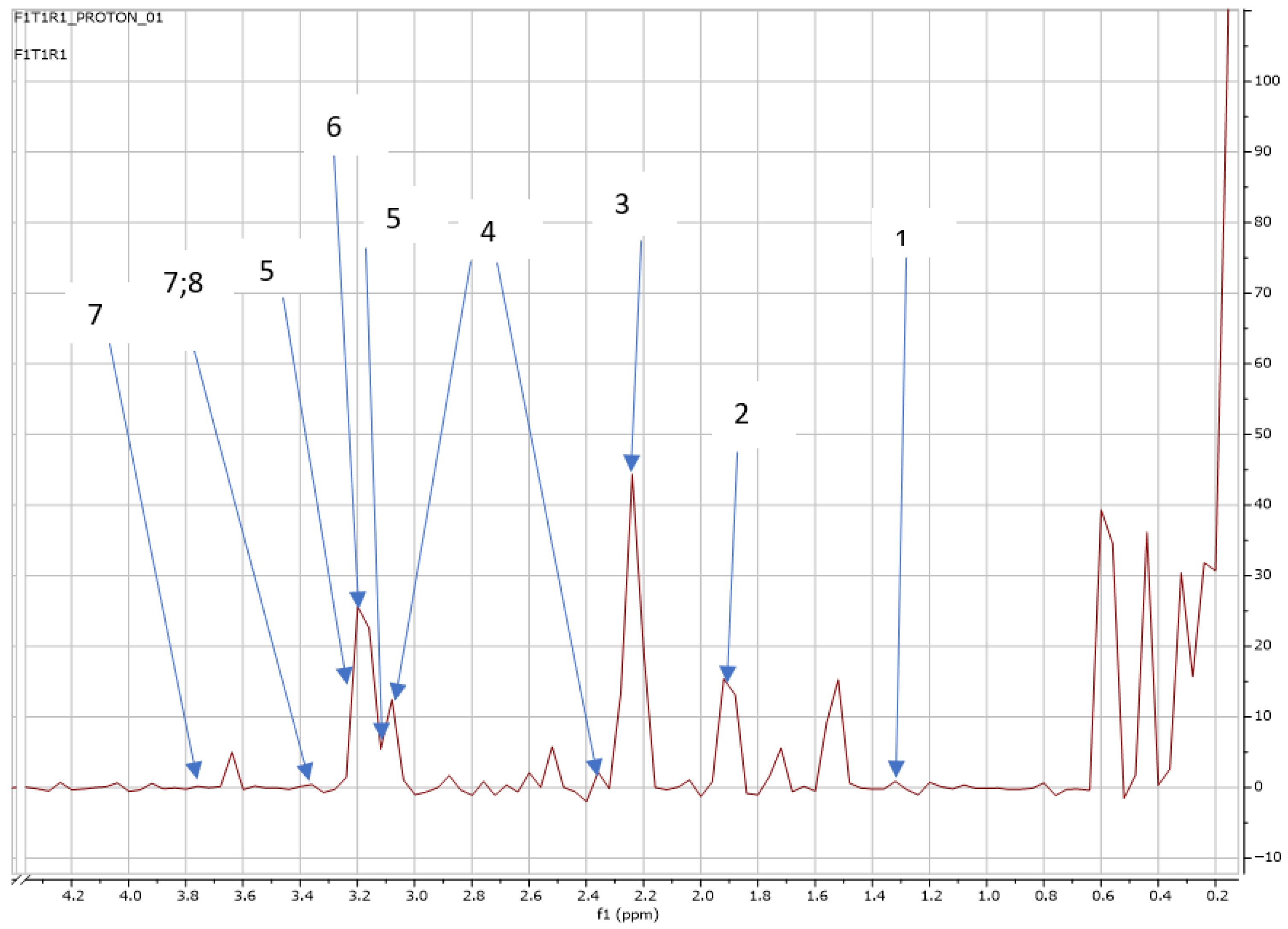
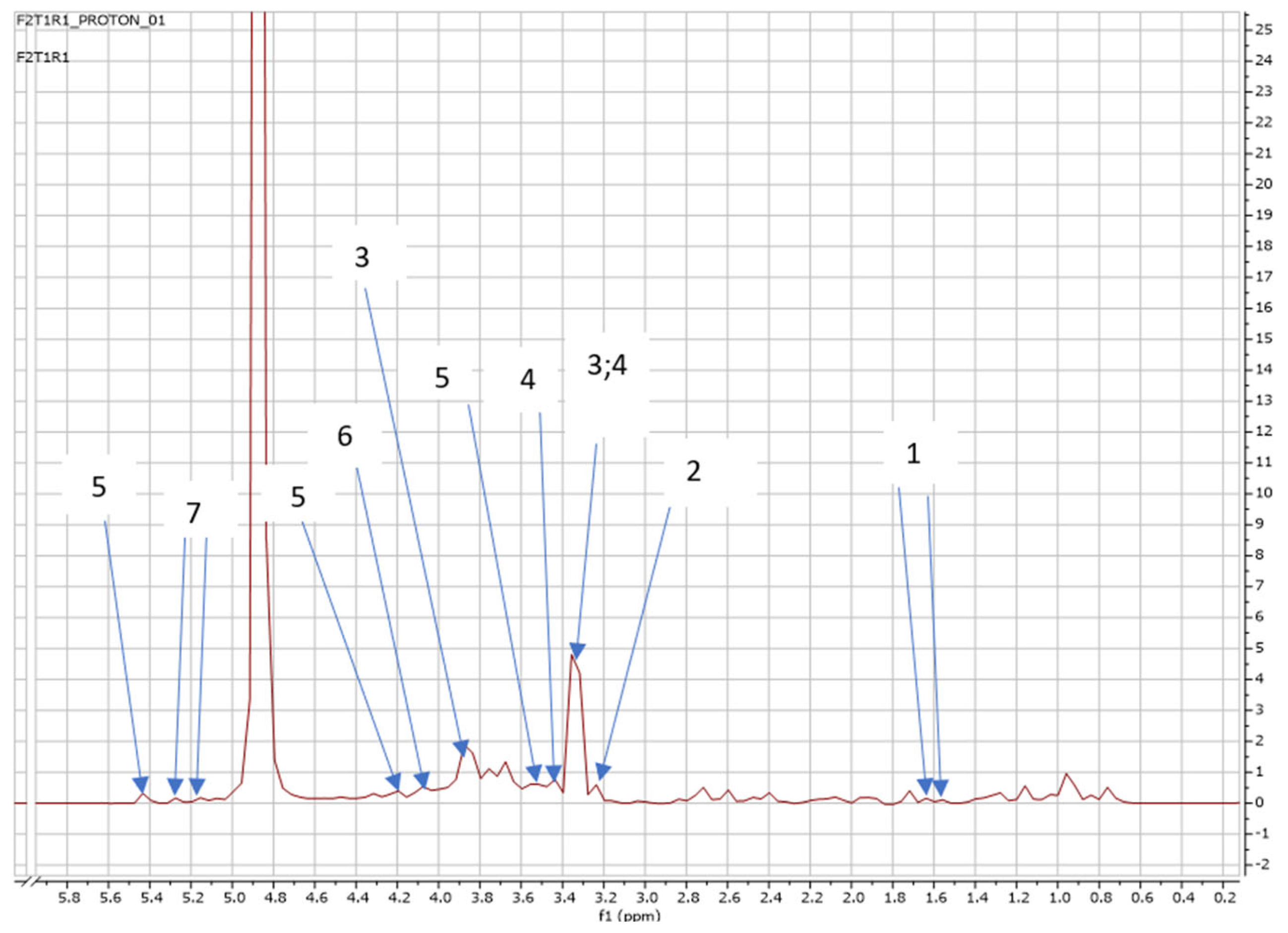

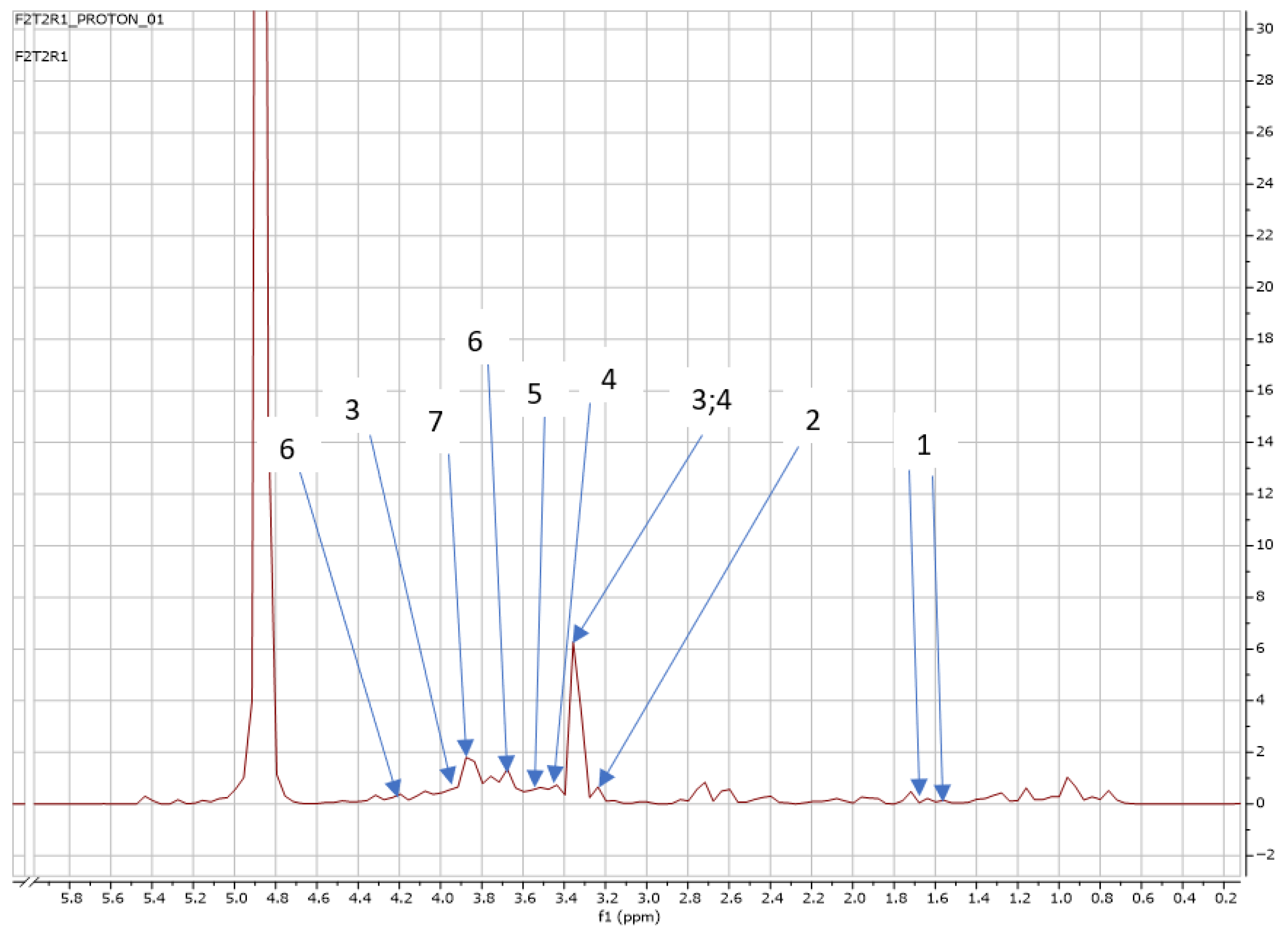
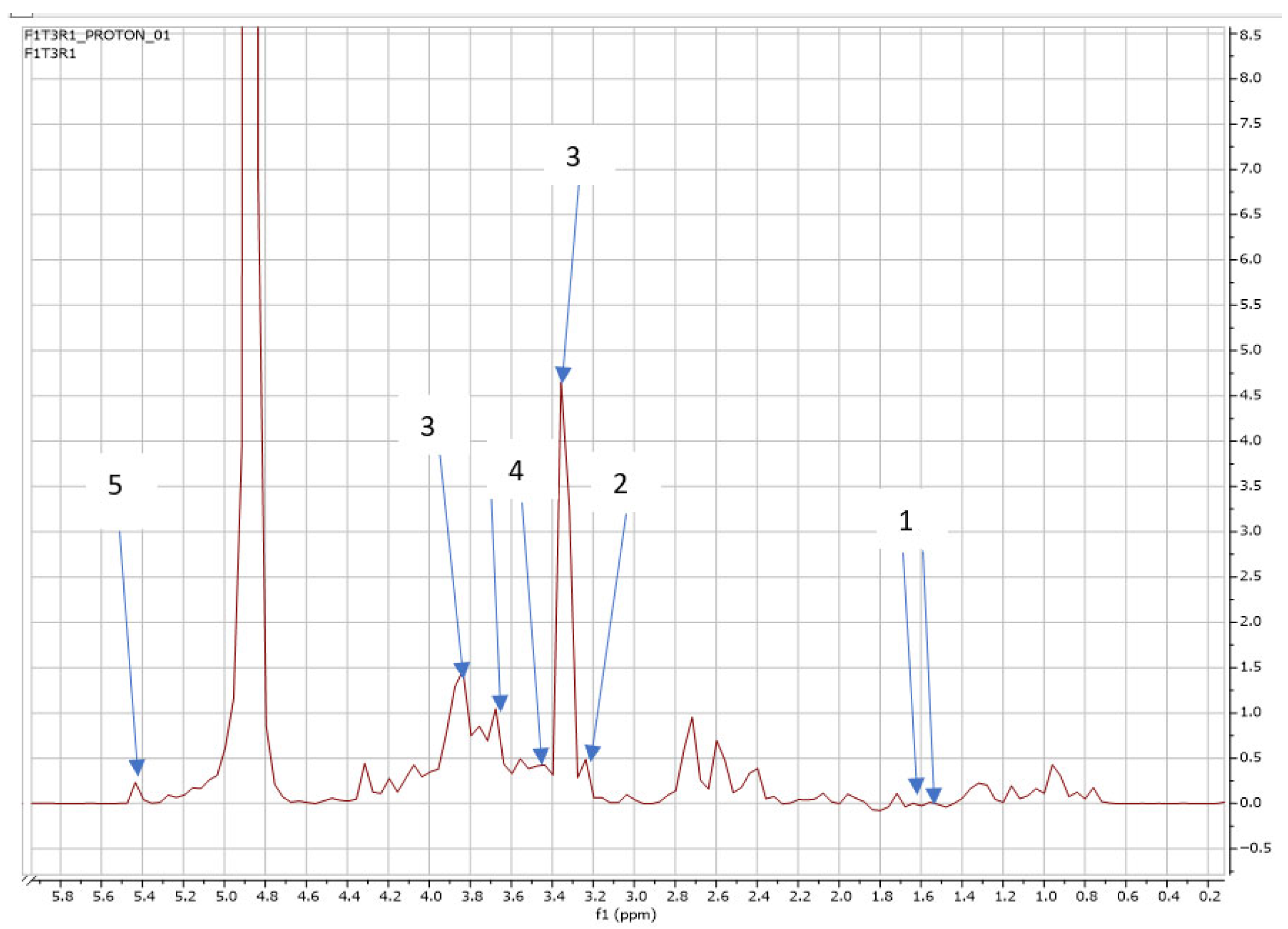
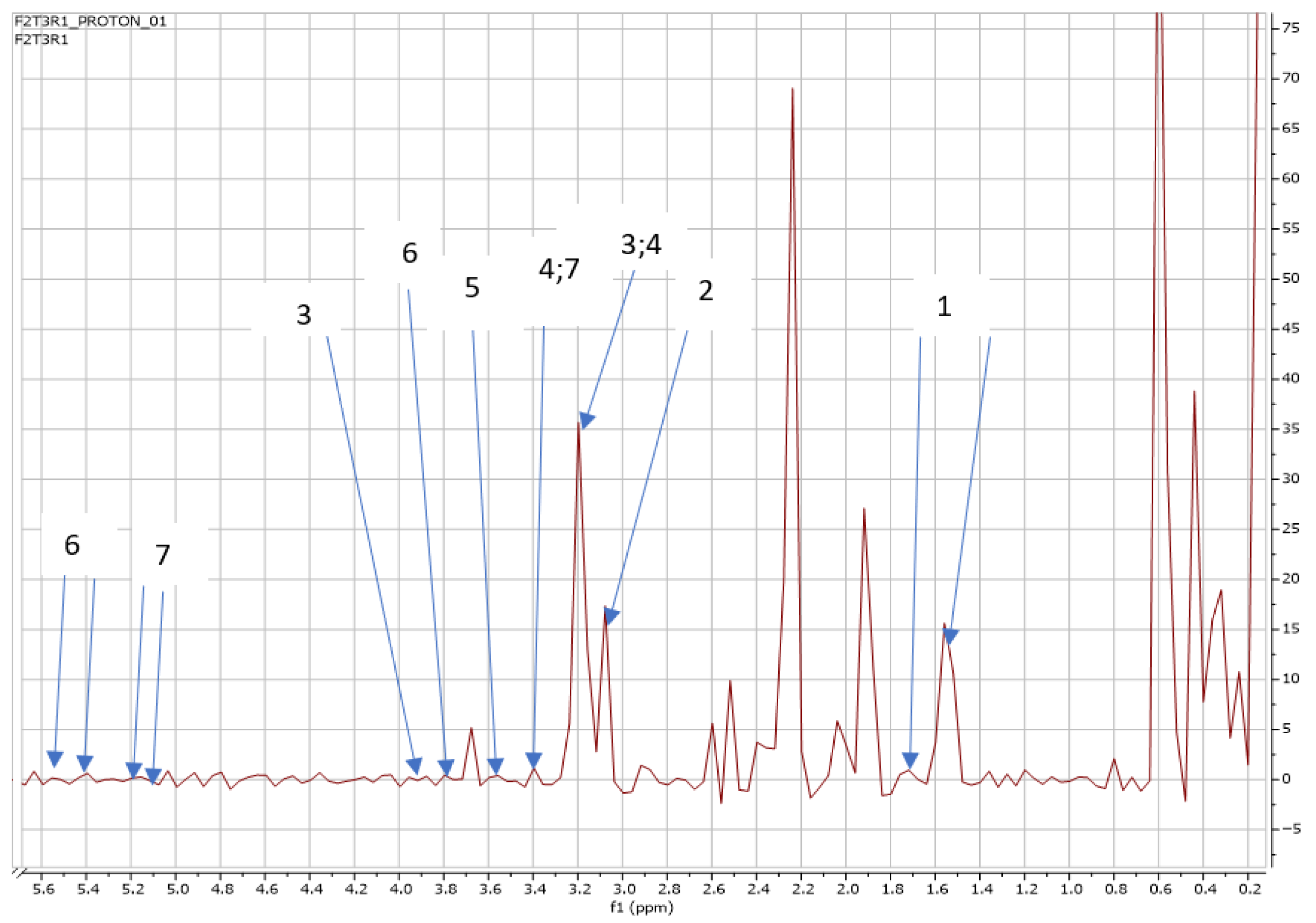
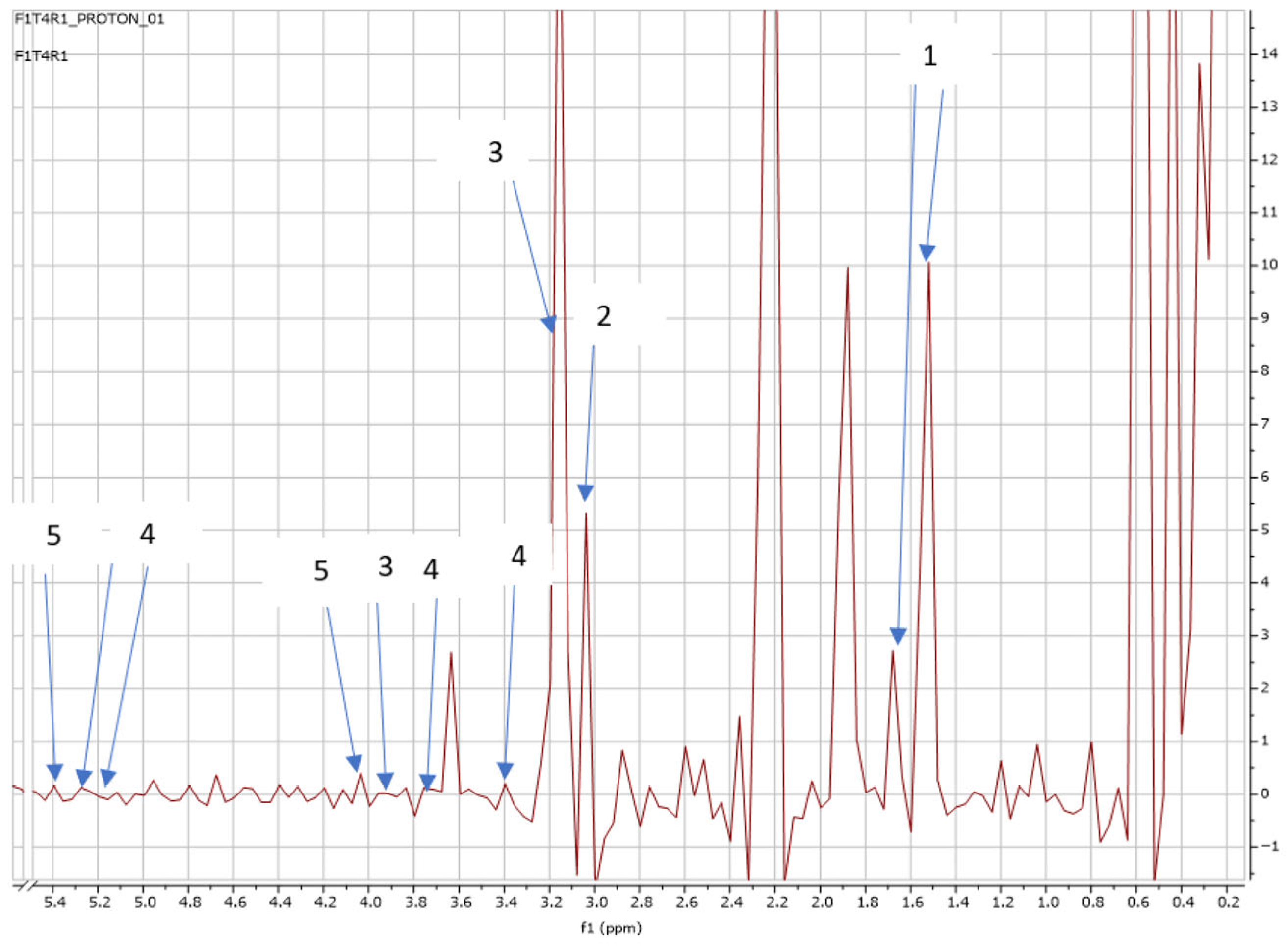
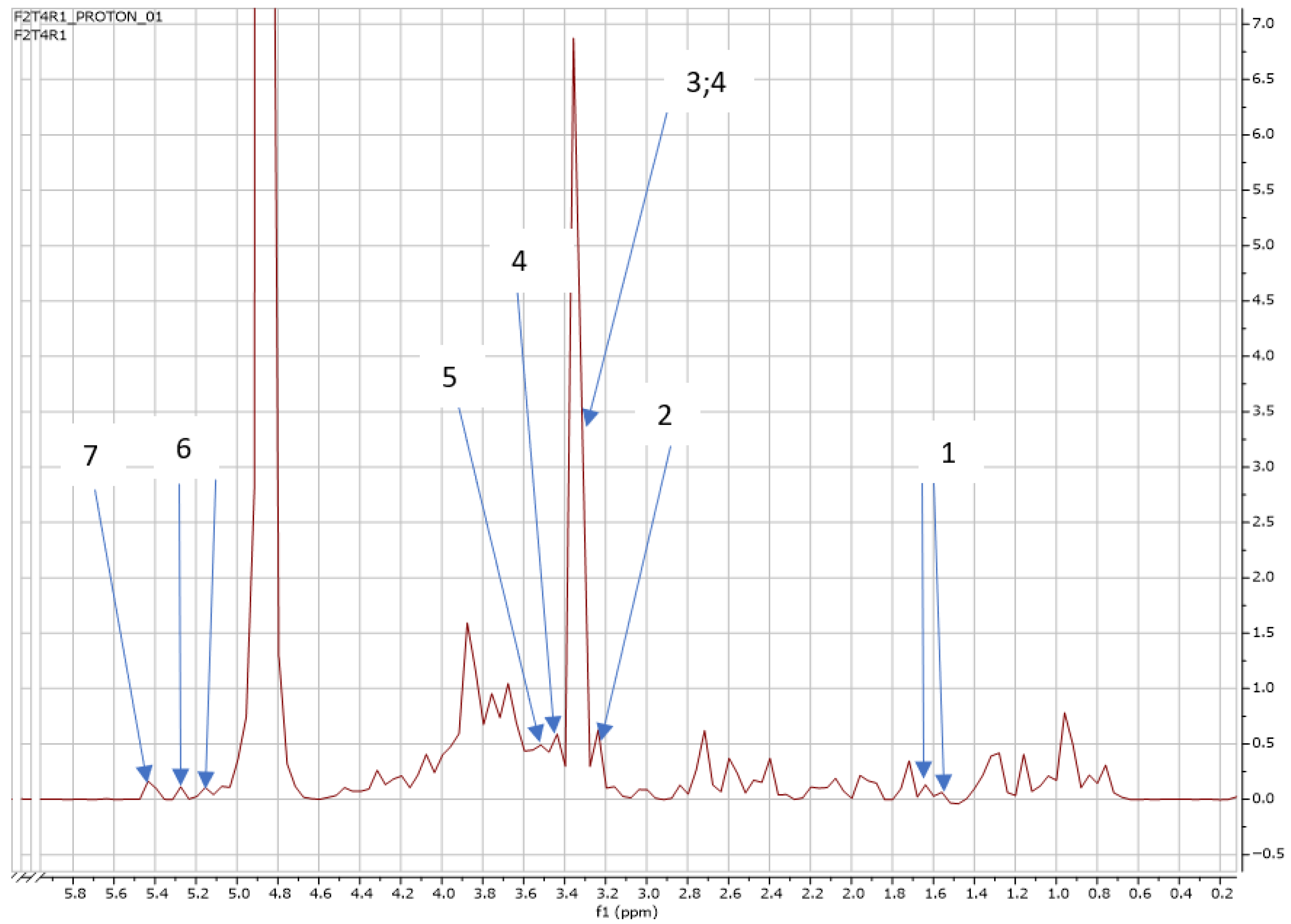
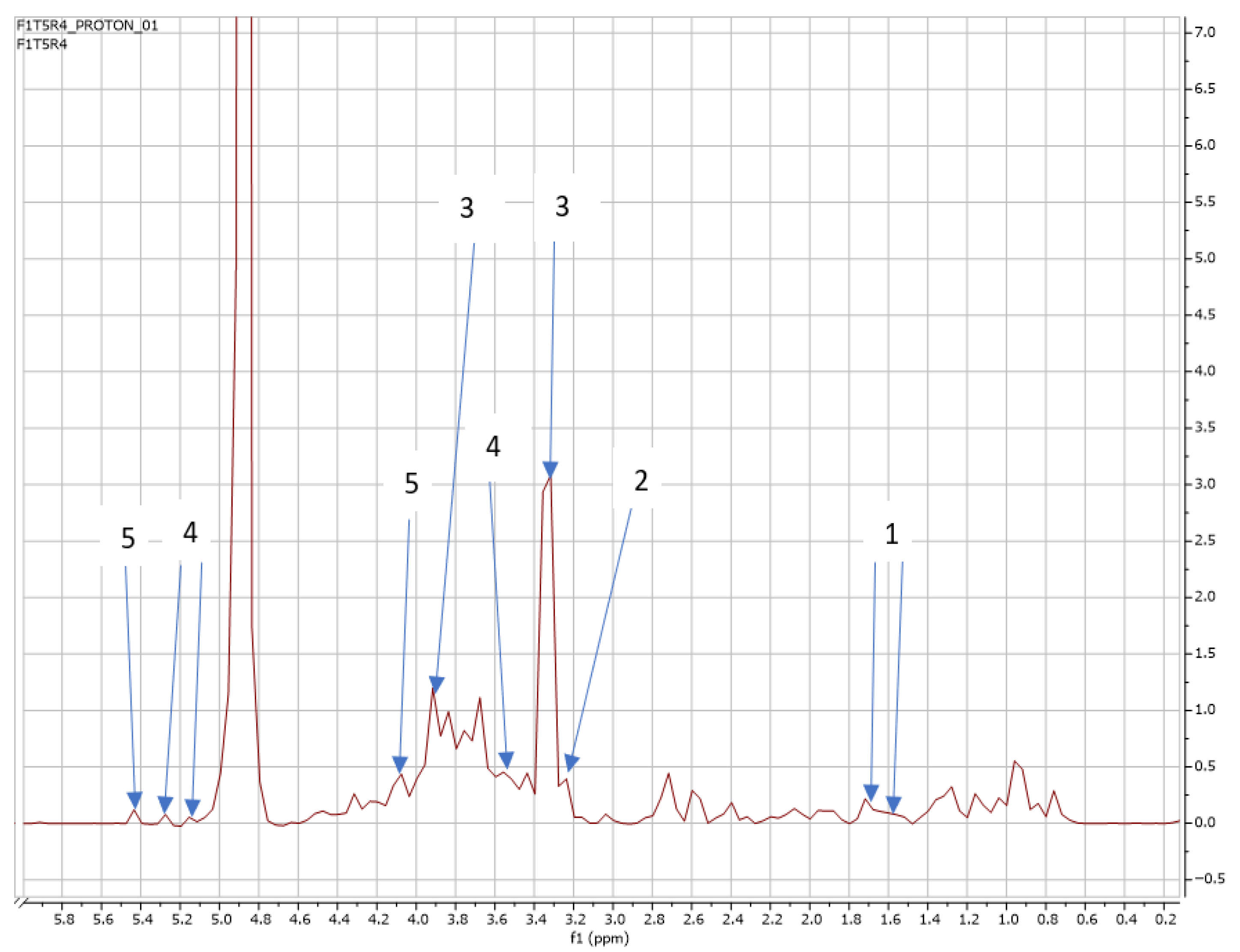
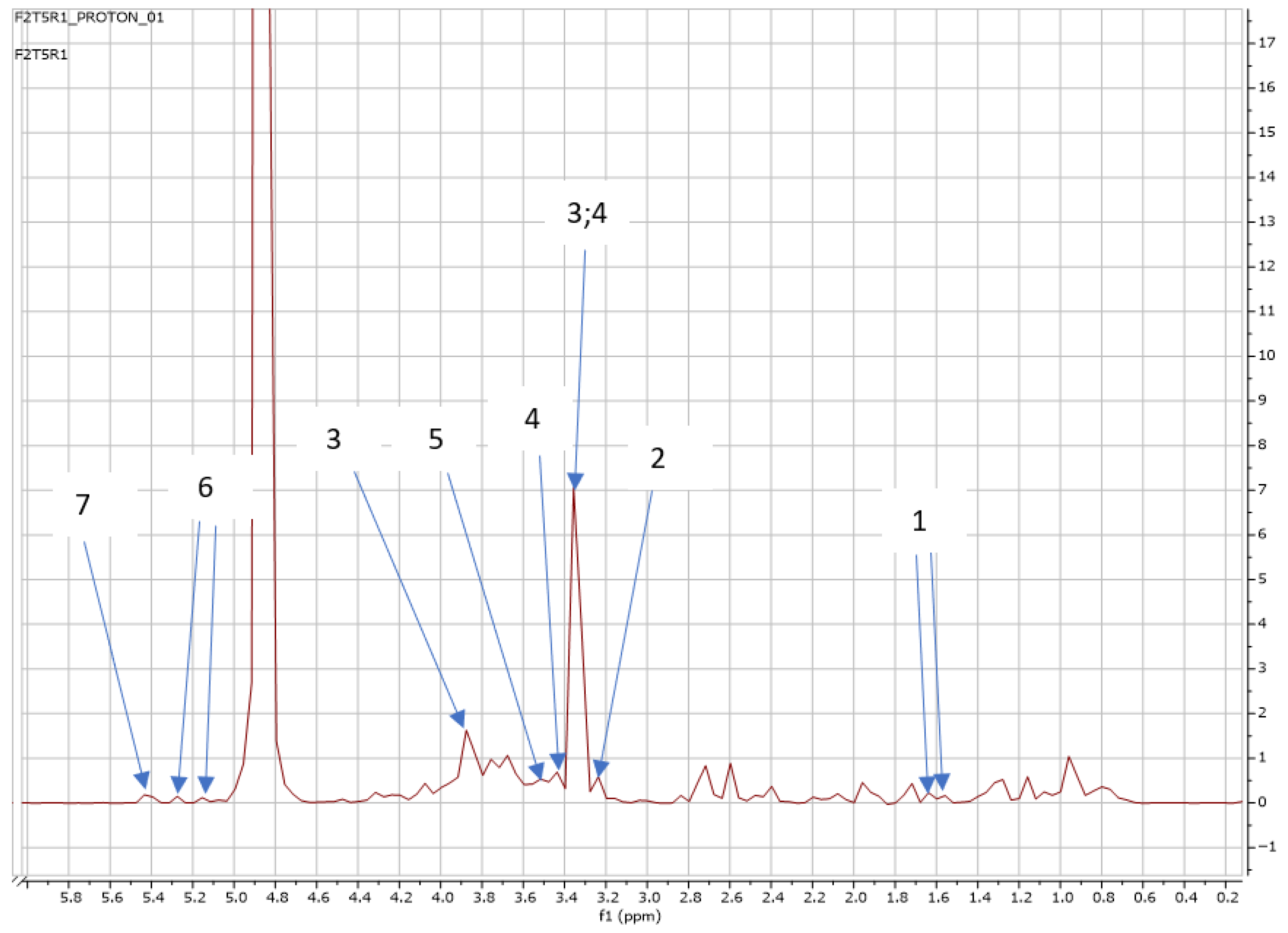
| Content | Quantity |
|---|---|
| Nitrogen, Phosphorus, and Potassium | 2:3:2 (22) |
| Lawn | 8:1:5 (25) |
| LAN (Limestone ammonium nitrate) | 28% |
| Ammonium sulphate (NH4)2SO4 | 21% |
| Vita flora Slow-Release Nitrogen (SRN) | 5:1:5 (33) |
| Vital flora Slow-Release Nitrogen (SRN) | 3:1:5 (26) |
| R2X (cum) | Q2 (cum) |
|---|---|
| 0.968 | 0.904 |
| Metabolite | NMR Region (ppm) | Chenomx | Human Metabolome Data Base (HMDB) |
|---|---|---|---|
| Caprate | 1.3 | 0.8, 1.3; 1.5; 2.1 | N/A |
| Thymine (C5H6N2O2) | 1.9 | 1.9; 7.4 | 1.86; 7.36 |
| Alanine (C3H7NO2) | 1.5; 1.6; 2.2; 3.1 | 1.5; 3.8 | 1.47; 3.77 |
| Carnitine (C7H15N) | 2.3; 3.1; 3.2 | 2.4; 3.3; 3;4; 4.6; 6.0; 7.3; 8.0 | 4.120 |
| Trimethylamine (C3H9N) | 3.2; 3.3 | 2.8; 3.6; 3.8; 4.2; 4.6; 8.2; 8.3 | 2.88 |
| Betaine (C5H12NO2) | 3.2; 3.3; 3.8; 3.87; 3.9 | 3.3; 3.9 | 3.25; 3.89 [40] |
| Trehalose (C12H22O11) | 3.4; 3.6; 3.7; 3.8; 5.2 | 3.4; 3.6; 3.8; 3.9; 5.2 | 3.42; 3.49; 3.63; 3.75; 3.81; 3.84; 3.85; 4.12; 5.18 [40] |
| 2 Deoxyadenosine (C10H13N5O3) | 3.4 | 2.6; 2.8; 3.6; 3.8; 3.9; 4.2; 4.6; 6.5; 8.2; 8.3 | N/A |
| Sucrose (C10H13N5O3) | 3.5; 3.6; 3.8; 4.0; 4.2; 5. 4 | 3.4; 3.6; 3.7; 3.8; 3.9; 4.0; 4.2; 5.4 | N/A |
| 1,3 Dimethylurate (C7H8N4O3) | 3.3; 3.4 | 3.3; 3.4 | 3.30; 3.43 |
| 1,6 Anhydro-β-D-glucose (C6H10O5) | 3.5; 4.1 | 3.5; 3.7; 4.1; 4.6; 5.4 | N/A |
Disclaimer/Publisher’s Note: The statements, opinions and data contained in all publications are solely those of the individual author(s) and contributor(s) and not of MDPI and/or the editor(s). MDPI and/or the editor(s) disclaim responsibility for any injury to people or property resulting from any ideas, methods, instructions or products referred to in the content. |
© 2025 by the authors. Licensee MDPI, Basel, Switzerland. This article is an open access article distributed under the terms and conditions of the Creative Commons Attribution (CC BY) license (https://creativecommons.org/licenses/by/4.0/).
Share and Cite
Motseo, T.; Nemadodzi, L.E. Determining the Effect of Different Concentrations of Spent Coffee Grounds on the Metabolomic Profile of Swiss Chard. Int. J. Plant Biol. 2025, 16, 88. https://doi.org/10.3390/ijpb16030088
Motseo T, Nemadodzi LE. Determining the Effect of Different Concentrations of Spent Coffee Grounds on the Metabolomic Profile of Swiss Chard. International Journal of Plant Biology. 2025; 16(3):88. https://doi.org/10.3390/ijpb16030088
Chicago/Turabian StyleMotseo, Thabiso, and Lufuno Ethel Nemadodzi. 2025. "Determining the Effect of Different Concentrations of Spent Coffee Grounds on the Metabolomic Profile of Swiss Chard" International Journal of Plant Biology 16, no. 3: 88. https://doi.org/10.3390/ijpb16030088
APA StyleMotseo, T., & Nemadodzi, L. E. (2025). Determining the Effect of Different Concentrations of Spent Coffee Grounds on the Metabolomic Profile of Swiss Chard. International Journal of Plant Biology, 16(3), 88. https://doi.org/10.3390/ijpb16030088







